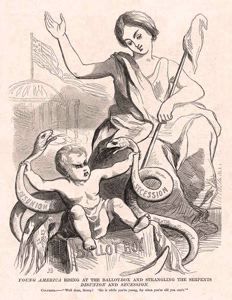
Winslow Homer, Young America Rising at the Ballot Box
This engraving is attributed to 19th-century painter and printmaker Winslow Homer, although there are sources that cite an unnamed cartoonist as the artist. Regardless, the image was printed for mass distribution in 1860 and featured in Harper’s Weekly just weeks before the 1860 election and the outbreak of the Civil War. The cartoon alludes to the Greek myth of Hercules’ birth. An illegitimate child of Zeus, Hercules’ existence sends Hera into a fit of rage, and she orders two snakes to strangle him, only for the unusually strong baby to instead strangle them. Homer imprints this story onto one of 19th century America, casting Hera as Mother America, a Statue-of-Liberty-esque woman who represents the bitter fragmentation of the country. Her snakes, “Disunion” and “Secession,” try to kill Hercules, who represents a “Young America,” or the American youth. The benign depiction of Hera reveals how the notion of America as strong and protected by her values is deceiving.
Young America encourages young people to vote and maintain the nation, and Homer seems to suggest that they will overcome the snakes of division. The quote at the bottom of the cartoon, “Well done, Sonny! ‘Go it while you’re young, for when you’re old you can’t,’” reveals the antagonistic dynamic between young and old. Suddenly far from the ideal, mothers represent the disillusioned and the fragmented. America’s mother figure is no longer a proud Lady Liberty, but a deceitful Hera, representing a fading way of life. This fading way of life signifies the youth leaving their immigrant roots and mothers behind so they may assimilate to American culture. It seems that mothers must make room for the new generation and sacrifice their past and future goals for the greater good. The children, rather than their mothers, are the future, empowered and accelerated by the American voting system.